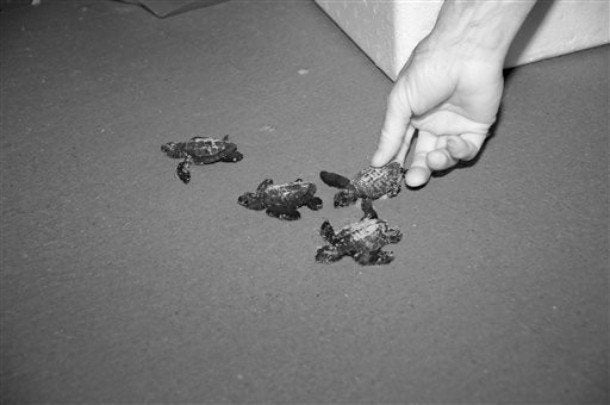
Federal wildlife officials embarking on a mass relocation of sea turtle hatchlings from the Northern Gulf Coast are hoping the endangered animals have a better shot of surviving if they're released off the East Coast of Florida instead.
But they're just not sure.
"The decision to move nests has been made only as the best of a bad set of alternatives," Debby Crouse, a sea turtle expert with the U.S. Fish and Wildlife Service, told reporters on Friday. The first 56 of what are expected to be thousands of hatchlings were released into the Atlantic on Thursday, rather than into the toxic soup that BP has made of their normal territory.
Officials determined that the latter would almost certainly have been lethal, but it's not at all clear that the newborns will be able to orient themselves or find food in their new habitats.
In fact, even as officials, activists and volunteers mobilize to help the Gulf of Mexico's sea turtles, they are essentially flying blind.
The BP spill has almost certainly done enormous damage to sea life in the Gulf, with sea turtles possibly suffering the most harm. These magnificent, graceful, normally long-lived creatures are particularly vulnerable to the effects of oil in the water, which weakens their eggs, chokes and poisons their young and leaves adults addled and starving. (See my July 2 article and slideshow, The Plight of the Sea Turtles.) One species in particular, the Kemp's ridley, battled its way back from the brink of extinction only a few decades ago to now face another possibly existential threat.
But as a new report just published by the National Academy of Sciences explains, critically important data that would allow scientists to accurately assess sea turtle populations simply doesn't exist. The report finds that "key data regarding birth and survival rates, breeding patterns, and other information" is essential to predicting and understanding changes in populations and creating successful management and conservation plans. But the federal government doesn't collect it.
The report, which was commissioned and finalized well before the spill, concludes: "The National Marine Fisheries Service and U.S. Fish and Wildlife Service should develop a national plan to assess sea turtle populations, improve the coordination of collecting data and sharing it with other organizations, and establish an external review of the data and models used to estimate the current sea turtle population and predict future population levels."
Karen Bjorndal, chair of the committee that wrote the report and director of the Archie Carr Center for Sea Turtle Research at the University of Florida, told the Huffington Post on Friday that the lack of basic information is troubling. "If we had the data that we say in this report we should have, we would be in a much better position right now trying to deal with what's going on in the Gulf," she said.
The focus on shore-based sightings and nesting could be deceptive, she said. Loggerhead turtles -- one of the six threatened or endangered species of sea turtle that make their home in the Gulf -- don't even reach sexual maturity until they are 36 years old, she noted.
"If all they're doing is sitting on the beach counting nests," she said, "there could be 36 years of disaster going on out in the ocean and we wouldn't know that from our current census."
Bjorndal's concerns echo those of other marine scientists, who worry that all the public's attention has been focused on what's been going on along the coast, when the greatest and longest term damage could be taking place offshore.
Meanwhile, in a video conference with reporters yesterday, federal officials said that surface burning of oil has resumed after being called off on account of high seas. But now, unlike before, there are federal observers on every "burn team" to make sure no turtles are incinerated by mistake.
The instinct of sea turtles to seek shelter and prey among floating vegetation is instead leading them straight to the very same thick clots of oil and oil-soaked seaweed that burn teams corral to set on fire.
Barbara Schroeder, sea turtle coordinator for the National Oceanic and Atmospheric Administration, said on Friday that although five observers have been going out with burn teams over the last several days, none have actually seen any turtles they could rescue.
Members of the Sea Turtle Restoration Project have demanded that the government halt the release of hatchling sea turtles from Padre Island National Seashore in Texas into the Gulf of Mexico, for fear that they would enter the oil slick and die.
But Crouse, from the Fish and Wildlife Service, said Friday that officials believe those turtles are far enough away from the spill zone. "We think they have a good chance of making it in the southern Gulf," she said. "We don't want to disrupt their orientation behavior and food-searching behavior."
Federal officials have also rebuffed a request from environmentalists to extend the seasonal shrimp fishing closure off the coast of Texas. Shrimp nets can drown turtles. But shrimp season opened Thursday night as scheduled.
And finally, a reminder that the oil spill isn't the only danger sea turtles face. Coming out of their nests at night, hatchlings instinctively count on moonlight to guide them to the sea. So artificial light sends them in the wrong direction, or in circles, until they die.
Here, via the Broward-Palm Beach New Times, is "a heartbreaking video from YouTube, posted by an activist group known as Sea Turtle Oversight Protection." Shot on the evening of July 10, it shows "activists attempting to guide some tiny sea turtle hatchlings in the right direction, i.e., toward the ocean. Unfortunately, the little dudes keep heading straight for the lights of Port Everglades, A1A -- or for the bright chandeliers of an empty ballroom." The volunteers also try to rescue a nesting female from under a chained-up beach chair.
WATCH:
*************************
Dan Froomkin is senior Washington correspondent for the Huffington Post. You can send him an e-mail, bookmark his page; subscribe to his RSS feed, follow him on Twitter, friend him on Facebook, and/or become a fan and get e-mail alerts when he writes.
